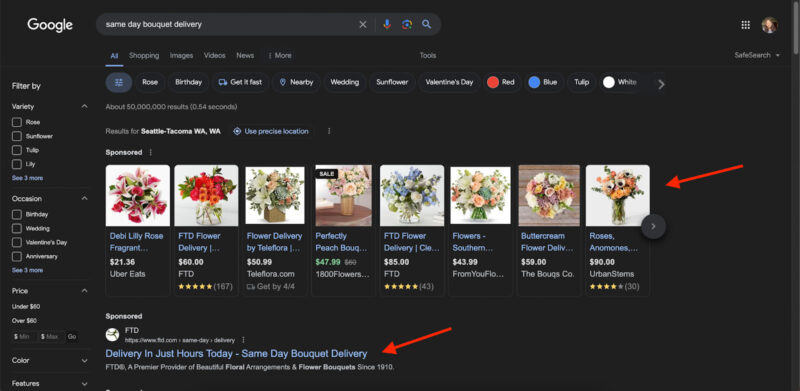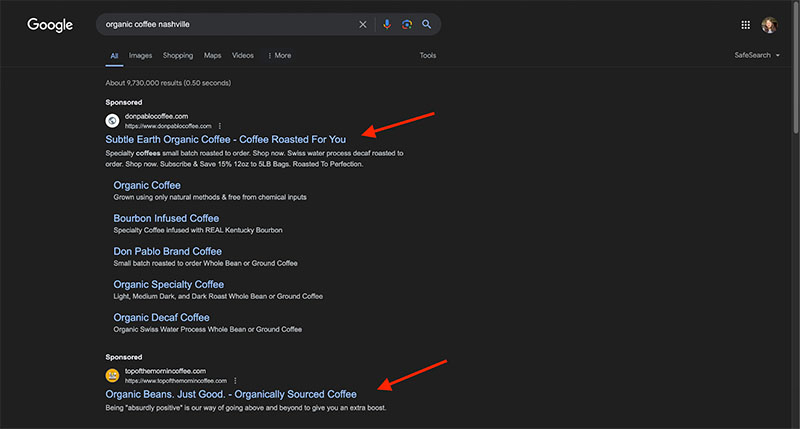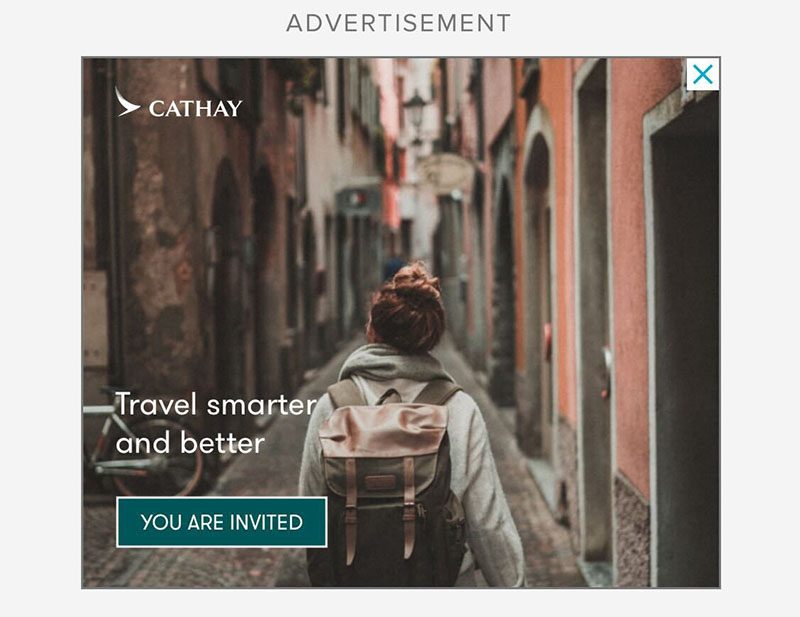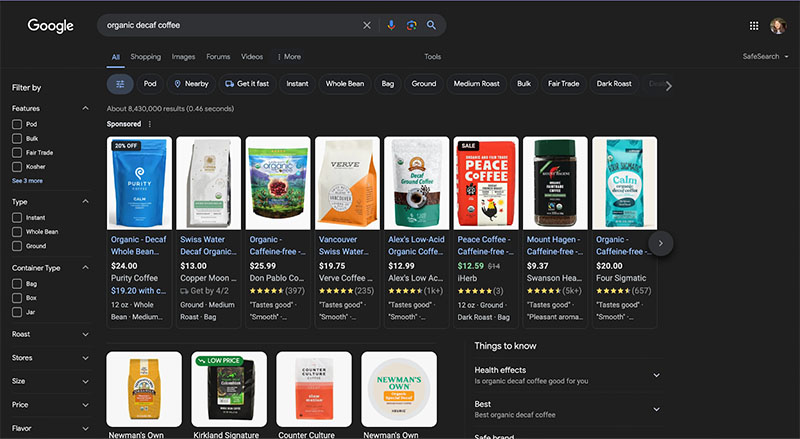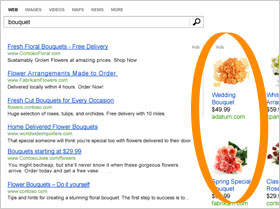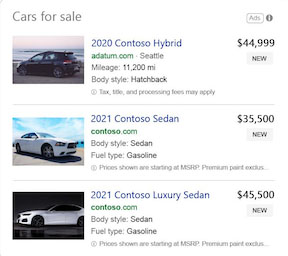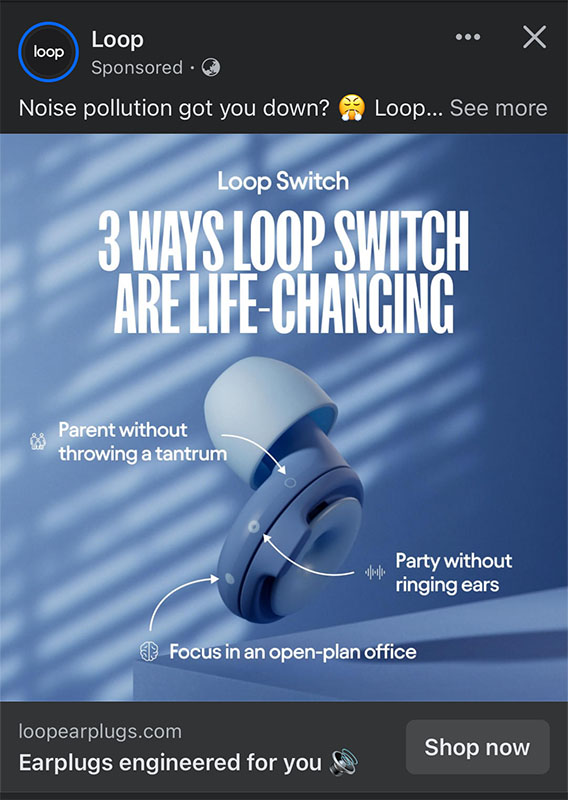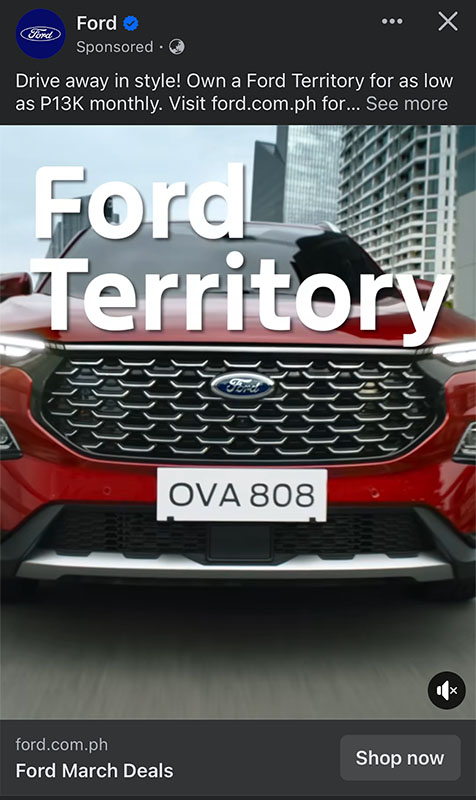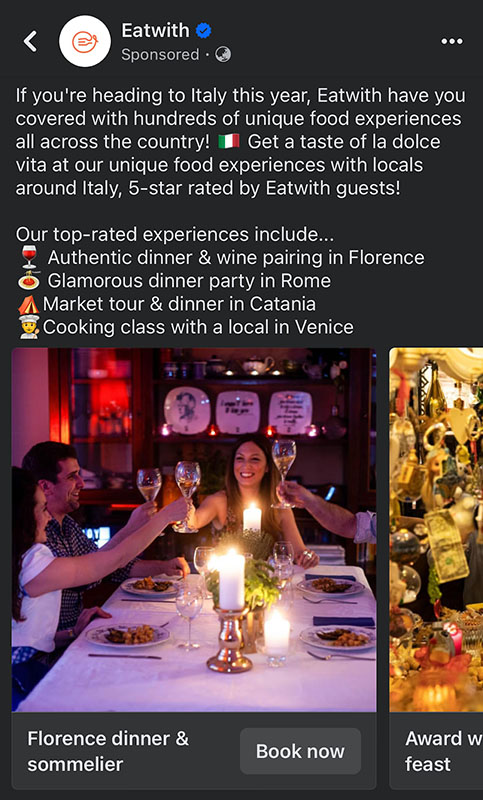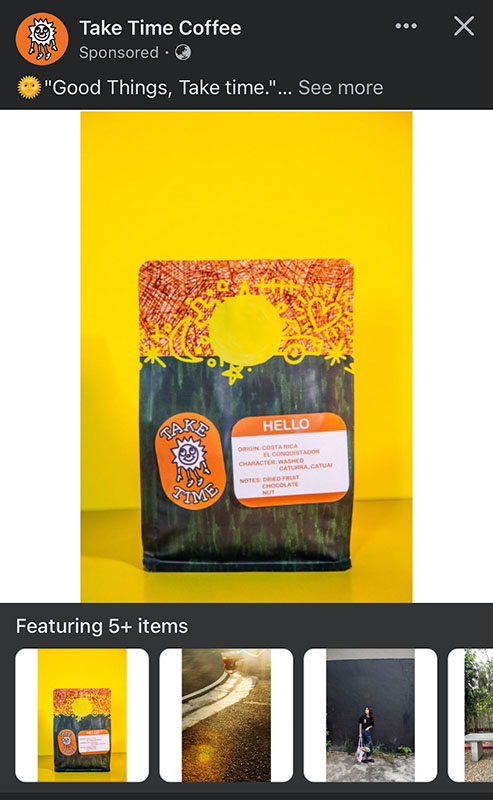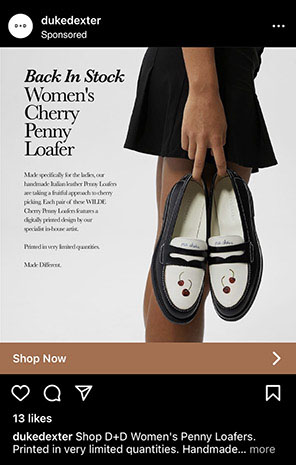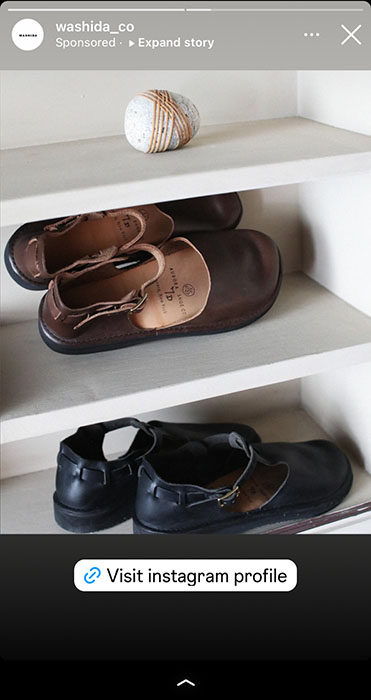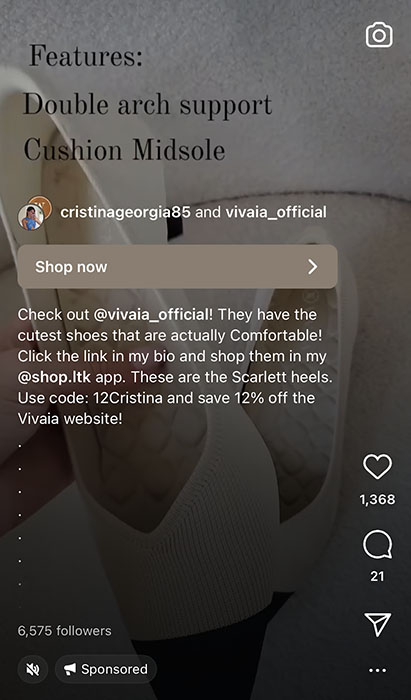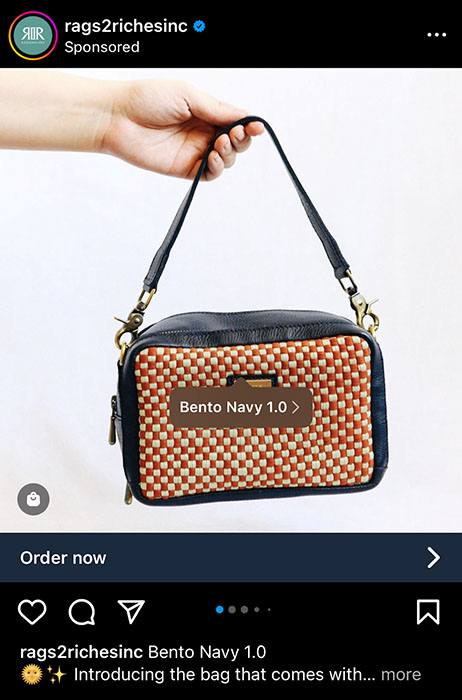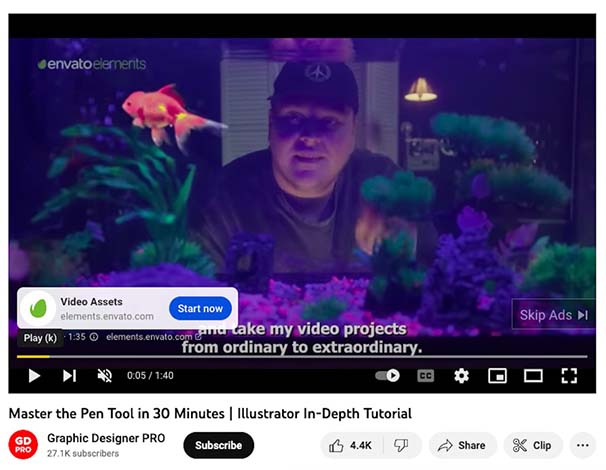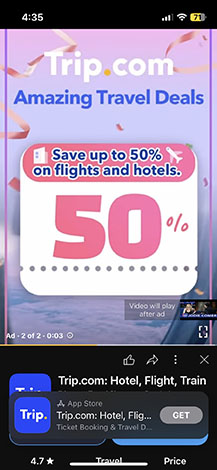Even if you don’t know what pay-per-click (PPC) advertising is, you’ve probably encountered it before. PPC ads appear at the very top of Google search results with a “Sponsored” tag, or as image or video ads on websites and social media.
Overall, PPC ads are a great way to bring widespread attention to your business in the online world. They’re also effective at generating clicks and traffic to your site or landing page. Best of all, they’re simple enough to set up, even if you have no advertising experience. Keep reading for a deep dive on what PPC is in marketing, how it works, and how it can help you reach your audience and build your brand presence.
A Deeper Look at What PPC Is
Here’s the simplest way to explain PPC in marketing: It’s an online form of advertising, most prominently on Google and social media. If traditional advertising involves television, radio, and print, PPC ads leverage the platforms where online users are most active: search engines and social platforms. And because online platforms collect user data, PPC ads allow for far more precise and effective audience targeting than broadcast advertising.
Because PPC is a form of advertising, it’s most effective as a bottom-of-funnel strategy, aka when users are nearing the very end of their purchase journey. Or, it also works as a remarketing strategy to re-engage customers with your business. Either way, PPC ads are most effective for getting results like clicks, leads, or conversions within a specific time period. This is why you’ll mostly see PPC ads for things like limited-time promos, coupons, or events.
The biggest reason to use PPC advertising is it’s effective and efficient. You can even see results in as fast as three months. In comparison, organic marketing, while effective, can take years to build. Plus, in a digital world where almost all your customers (and potential customers) are on Google, social media, and Microsoft, PPC ads are a guaranteed way to get the word out about your business to thousands of people—and get them to take action.
However, aside from this benefit, there are three other reasons why PPC ads are a beneficial marketing strategy:
- PPC ads have precise audience targeting: With PPC advertising, you can get precise data to target your audience, such as their interests and website behavior, directly from your platform. In that sense, it’s more effective than traditional advertising, which mostly employs a “spray and pray” method where you don’t have much audience data beyond locations and time slots.
- It’s cost-effective: Because you only pay for each click your ad gets, it’s a much more economical way of advertising your small business overall. You can set a daily ad budget that fits your budget capabilities, and your ad platform will automatically adjust to it. It’s also easy to update later on to target a larger audience or a different audience set altogether.
- It allows audience engagement and action: You can’t interact with a TV ad, but you can click on a PPC ad that catches your eye. PPC ads allow audiences to engage with your ad, click links to your website or landing page, and even make a purchase. In short, digital ads aren’t just a monodirectional journey like traditional ads—they also offer a subsequent action.
How PPC Works
As an advertising model, PPC advertising is simple. You place your ads on your chosen platform, whether that’s Google, Facebook, TikTok, and so on (more on these below). Then, choose the audience your ad will target, set your ad budget and how long your campaign will be (along with a few other settings), and your ad will automatically go live as soon as it’s approved by your platform.
When your target audience sees and clicks on your ad, it’ll lead them straight to your landing page, whether that’s your website home page, your event sign-up form, and so on. Only then will you pay for your ad (hence the name “pay per click”).
Here’s an overview of how PPC advertising works:
- Step 1: Choose an ad platform. Many factors go into choosing the right platform for your PPC ads. Some of these are your primary ad objective, your target audience, and the type of ad you want to create.
- Step 2: Create an ad account. Google and social media platforms all have their respective advertising platforms, for example, Google has Google Ads, and Instagram (IG) and Facebook (FB) have Meta. Creating an account is completely free—you only pay once you set up your ad.
- Step 3: Choose your PPC campaign. Each platform also offers several types of ad campaigns. For instance, Google has Search Ads, which show up on search results, or Display Ads, which are images or videos. Social media ad platforms have sponsored posts, image carousels, and so on.
- Step 4: Set up your ad campaign. After choosing your campaign type, you’ll need to set up its details, such as its headlines, descriptions, links, images (if you have them), and its landing page.
- Step 5: Choose your target audience. The most important part of your ad is its target audience. PPC ads allow precise audience targeting, which means you can target your ad according to specific parameters like audience demographics, locations, website browsing history, topic interests, shopping behavior, and searched keywords.
- Step 6: Set your ad budget and campaign length. One of the best benefits of PPC advertising is that it’s budget-friendly. You can set a daily budget cap for your campaigns and your ad platform will automatically adjust to your maximum ad bid (PPC ads work on an auction system). You’ll also set how long it’ll be live.
- Step 7: Submit and monitor your ad. Once you submit your ad, your platform will need to review it to ensure it follows policies, after which it’ll automatically go live once it’s in the clear. The final stage is to monitor your ad’s effectiveness against your initial objectives, e.g., its click rates, impressions, conversions, and so on.
PPC ads work on an auction system, just like traditional advertising. The higher your ad bid, the greater your chances of securing a prime ad spot that matches your preferences (i.e., your target audience and keywords). However, ads are also ranked based on factors like quality and ad format.
Where to Place PPC Ads (+ Examples & Costs)
Understanding PPC campaigns is also about knowing where you can host them. Most PPC ads live on Google and social media platforms, but a handful other search engine and ecommerce platforms are gradually hosting them as well, like Bing and Amazon. The platform you choose to run your PPC ads depends on a number of factors—most of all your audience, ad type, and objective.
Below are the platforms where you can set up PPC ads, along with some examples and their average costs.
1. Google
Google is undoubtedly the biggest player in PPC ads, partly because it’s one of its earliest adopters. As the number one search engine in the world, Google has the largest user base and audience who you can target based on demographics, purchase intent, browsing behavior, interests, and even life milestones (like marriages or graduations), or set custom preferences.
There are three main types of Google Ads:
- Search Ads: These are ads that appear at the very top of Google search results and are marked by a “Sponsored” tag. They appear when users search for certain keywords related to your business or product.
- Display Ads: These are image or video ads that appear on websites relevant to your ad. They come as static banner image ads, responsive ads, and video ads.
- Shopping Ads: These are ads that, when clicked, lead users directly to your product purchase page. They’re targeted to people at the very end of the purchase journey and are using Google specifically to search for certain products (e.g., “organic coffee beans”)
Here are the average costs for PPC Google Ads:
- CPC (cost-per-click): 11 to 50 cents
- CPM (cost per thousand impressions): 51 cents to $1
Source: WebFX
Find out more about Google Ads and how to set them up in our guide to Google advertising.
2. Microsoft
Formerly known as Bing Ads, Microsoft Ads are Microsoft’s version of Google Ads. They function similarly to Google Ads in that they appear on both search engine results and as images on relevant websites, and they even have similar setup processes. The main difference is the audience size and demographic: Google has an undeniably larger audience than Bing.
However, Bing’s smaller audience means you can have more precise audience targeting than with Google. Also, Bing’s audience skews slightly older, predominantly male, and has a higher income.
Microsoft offers six main ad types:
- Search Ads: These are ads that appear at the very top of Bing search results. Bing offers Responsive Search Ads, which use your ad’s most effective headline and description combination, Dynamic Search Ads, which are automatically generated and placed by Bing based on your website content, and Bing Smart Search Ads for newer interfaces.
- Multimedia Ads: These are image and video ads that are shown as banners on Bing search results and across Microsoft’s platforms.
- App Install Ads: These are ads with the specific objective of driving app installs. They appear on Bing search results and on Microsoft’s app store, and adjust automatically according to the user’s operating system (Apple or Android, etc.).
- Audience Ads: These use artificial intelligence (AI) to target media ads based on Microsoft users’ specific behaviors and preferences, such as their purchase intent. They’re displayed across all Microsoft sites.
- Product Ads: Similar to Google’s Shopping Ads, these appear when users search for a specific product on Bing. They are likely at the very end of the customer journey and are highly likely to proceed with a sale.
- Vertical Ads: These are entirely AI-generated ads by Microsoft that require no keywords. They’re automatically generated, set up, and personalized by Microsoft to each user.
Here are the average costs of Microsoft PPC ads:
- CPC: 11 cents to 50 cents
- CPM: 51 cents to $1
Source: WebFX
Find out more about Bing’s ad types. Then, learn how to set them up in our guide to Microsoft Advertising.
3. Facebook
In the social media world, Facebook is still the undisputed king. It has the largest audience size and is still the most-used social app in the world. Its audience size, diversity, and content variety all make it a prime platform for PPC advertising.
Facebook PPC ads include regular static images, videos, and image carousels, and can target audiences by demographic, interests and preferences, or even their website browsing behavior. For example, you can target your ads to people who follow specific pages and view a certain website.
Here are the types of PPC ads available on Facebook:
- Image Ads: The most standard ad type on Facebook, these are regular static images that appear on users’ feeds according to their interests, demographics, preferences, and more. When clicked, they can lead to your website, app store page, or any other landing page.
- Video Ads: These function identically to image ads, except in video format. Because they’re videos, they often have higher engagement rates.
- Carousel Ads: These are several images (up to 10) placed in a carousel. They allow for multiple links and are most effective at driving clicks and conversions.
- Instant Experience Ads: Instant Experience Ads are unique to Facebook. They also appear as images or videos on users’ feeds, but when clicked, instantly give users a full-screen custom experience instead of a regular landing page.
- Collection Ads: These are similar to Shopping or Product ads. They showcase specific products from your brand and are meant to capture and convert end-of-funnel audiences.
Here are the average costs of PPC ads on Facebook:
- CPC: 26 to 50 cents
- CPM: $1.01 to $3
- Cost per like: Up to 25 cents
- Cost per download: Up to $5
Source: WebFX
Find out more about Facebook advertising costs to keep in mind. Then, check out our guide on how to set up Facebook ads.
4. Instagram
If visual ads are your focus and you want to target a mostly younger demographic, Instagram is likely your best bet for PPC ads. As Facebook’s sister company, Instagram ads are also set up via Meta Business Suite and function nearly identically with similar audience targeting. The main differences are Instagram’s ad costs can be slightly higher and its platform has a narrower user base and a younger demographic.
Here are the PPC ads you can set up on Instagram:
- Image, Video, and Carousels Ads: These Instagram PPC ad formats are similar to their counterparts on Facebook. They appear on users’ feeds alongside organic content and when clicked, lead to a landing page.
- Instagram Story Ads: These are one of Instagram’s biggest advertising advantages over Facebook. While Facebook also has its own Stories feature, Instagram’s are far more effective with its audience. Instagram Story ads can be images or up to 60-second videos.
- Reels: These are Instagram’s short-form vertical video ads. They can be up to 30 seconds long and can link directly to your landing page or Instagram Shop when clicked. They’re also a good option for creating more authentic-feeling ads.
- Instagram Shop Ads: These are image ads that appear with product tags that when clicked, lead users to your Instagram shop, if you have one. Like Facebook’s Collection Ads, they’re best suited for encouraging audiences to follow through with a purchase.
Here are the average costs of Instagram PPC ads:
- CPC: Up to 25 cents
- CPE (cost per engagement): 3 to 8 cents
Pro tip: Since Facebook and Instagram are both under Meta, you can cross-post ads on both platforms via Meta Ad Manager. Find out more about both in our guide to social media advertising. Or, learn how to build your social media plan with our free template.
5. YouTube
PPC ads on YouTube appear mostly as buttons attached to video ads, but they can also live as boosted listings on YouTube’s home page or on the sidebar when users watch a video. YouTube is unique in that all of its content is videos, so audiences are generally more engaged than with other social platforms. Also, because PPC management on YouTube is done via Google, they have the same audience targeting features.
Here are the types of PPC ads you can run on YouTube:
- Skippable Ads: These are pre-roll ads on YouTube that viewers can skip. You’ll only need to pay when audiences click on your call to action (CTA) or watch at least 30 seconds of your ad.
- Non-skippable Ads: These are unskippable ads that appear before or midway through a video. With these ads, you only pay when your CTA is clicked.
- Bumper Ads: These are similar to non-skippable ads, but are only five seconds long. Therefore, they’re most effective for getting a short and clear message across to your audience.
- In-feed Video Ads: These appear as thumbnails in users’ home feeds or alongside related videos. As with non-skippable ads, you only pay for every click it gets.
While the platforms above are some of the most prominent for PPC ads, they’re not the only ones available. There are many other social media platforms that allow pay-per-click advertising, each with its own strengths and audiences. Ecommerce platforms like Shopify are also gradually allowing user advertising on their platforms.
Here are some of the other platforms where you can place PPC ads:
- TikTok: Best known as the best way to reach Gen Z audiences, TikTok offers PPC ads that appear in users’ feeds and shopping ads that lead users directly to your TikTok store.
- X (formerly Twitter): Like Facebook, X’s (aka Twitter’s) PPC ads appear as text, images, videos, or image carousels. However, they also have website cards to drive visibility and clicks to your website.
- Amazon: If you sell products on Amazon, it also has options to place PPC ads around its website. Amazon’s ads function very similarly to Google, only for specific product keyword searches instead of general ones. Your ad will show up as a “Sponsored Product” when people search for a specific item.
- Shopify: Similarly, if you sell your products on Shopify, you can also advertise them on the platform. However, you’ll first need to qualify to be a Shopify Partner.
PPC Tools for Small Businesses
The primary tool you’ll need to do PPC advertising is your platform of choice—Google, TikTok, and so on. However, those shouldn’t be your only tool if you want to create effective PPC campaigns. Like any marketing campaign, good PPC advertising takes careful research and strategy, which is where the tools below can help:
- Keyword research tools: These are especially vital if you plan to advertise on Google, Microsoft, or Amazon, which use keyword-based advertising. Finding the right keywords to target can make the difference between a successful campaign or wasted ad spend. Some of the most helpful keyword tools are Semrush and Ahrefs—find more about them in our guide to the best keyword research tools.
- Ad creative platforms: You’ll also need creative platforms and tools to create your ad, particularly for display ads. Adobe tools like Illustrator and Photoshop are the industry standard, but there are also many free, beginner-friendly design platforms like Canva and VistaCreate, or you can hire freelance graphic designers via Fiverr.
- Copywriting tools: If you need an extra hand with your ad copy and descriptions, artificial intelligence (AI) tools like Copy.ai can help (just be sure to always revise and refine the output before finalizing). Find out more AI content writers. Or, you can also hire a freelance copywriter via Fiverr.
- PPC management tools: Managing PPC ads can be a lot to handle, especially if you’re juggling multiple campaigns simultaneously. PPC management tools like Sprout Social can help with this. These platforms can help you set up, configure, and manage multiple PPC ad campaigns from one place.
- PPC analysis and reporting: The most important part of your campaign is to measure its results against your objectives, and therefore determine its effectiveness. The tools for measuring your campaign results will depend on your ad platform, such as Google Analytics for Google Ads, Meta Business Suite for Facebook and Instagram, and so on.
PPC Best Practices: Do’s & Don’ts
Beyond knowing what PPC is in marketing and how it works, you’ll also need to know some of its biggest do’s and dont’s before getting started. PPC advertising is a unique practice in that it’s native to digital marketing and therefore fairly new, but it’s also grounded in traditional advertising structures. Altogether, these factors make it one of a kind.
So if you’re aiming to get started with PPC advertising, here are some of the biggest do’s and dont’s to keep in mind:
- Do choose the best platform for your objectives: No two PPC platforms are the same. Some, like Google, can generate keyword-driven site traffic, while others, like TikTok and Instagram, are better suited for end-of-funnel conversions. Focus your efforts on the platform(s) that best serve your goals.
- Do keep your ad clear and simple: Your audience will probably only see your ad for a split-second, during which it’ll immediately need to leave an impression. This means your ad should get your message across in a few short words.
- Do target your audience: One of the biggest benefits of PPC advertising is the ability to target audiences precisely, so take advantage of those features. Most platforms let you target audiences by demographic, interests, and even buying behavior and visited websites.
- Do address your audience’s needs: For your PPC ad to be impactful, it needs to be relevant to your audience. The best way to do this is by creating ads that directly address your target audience’s needs. For instance, if they’re looking for door-to-door bouquet deliveries, mention that in your ad.
- Do include keywords in your ad: Keywords help your ad appear in the right places, i.e., where people are most likely searching for your product or service. This goes for both search and display ads.
- Don’t run too many ads at once: Spreading yourself out too thin will only likely lead to wasted ad spend. Instead, build one or two ad campaigns at a time, and then measure your results and recalibrate your strategy when necessary.
- Don’t forget your CTA: Every good display ad needs an effective call to action (CTA) to drive audiences to complete your desired action, whether it’s clicking on your link or signing up for your newsletter. CTAs guide your audiences to where they need to go after seeing your ad.
- Don’t neglect remarketing: PPC ads are also especially useful for remarketing, aka when you want to bring previous customers back to your business. You can use PPC ads to retarget customers based on their previous behavior, say if they previously browsed your website or bought from your online store.
Frequently Asked Questions (FAQs)
PPC in marketing stands for pay-per-click advertising. It’s a form of digital advertising on search engines and social media platforms where you can advertise your brand and only pay each time your ad is clicked. Much like traditional advertising, PPC ads operate on an auction basis where the higher your bid, the greater your chances of reaching your audience. However, because they’re digital, PPC ads allow for far more precise audience targeting.
PPC is an important addition to your marketing strategy because it’s effective at getting results in a specific time period, whether that’s link clicks, website traffic, leads, or conversions. And, it does so for a relatively low price—you can set a maximum daily budget that fits your capabilities. PPC advertising is also particularly effective at converting end-of-funnel leads or retargeting customers.
Yes. One of the best benefits of PPC advertising is that anyone, even small business owners with no digital marketing experience, can do it on any budget. If you have a business account on platforms like Google, Meta, or Microsoft, you can set up PPC ads on any budget you like. You’ll have full control over your target audience, campaign length, and settings, and you can take your ads down anytime.
Bottom Line
If you’ve ever been curious about what pay-per-click marketing is and how it can help your business, you’re on the right track. PPC advertising can help your business reach your audiences in a short time and with little effort—and because you only pay for each click, it can be very cost-effective when done right. In today’s highly competitive digital landscape, it’s a worthwhile addition to your marketing strategy.
It’s one thing to know what PPC is, but implementing it the right way is another matter. If you’d rather leave your PPC ads to experts, a digital marketing agency like Straight North can help. Straight North offers PPC services especially for small businesses, so you know you’re in the right hands. Visit their website today to book a free consultation.
